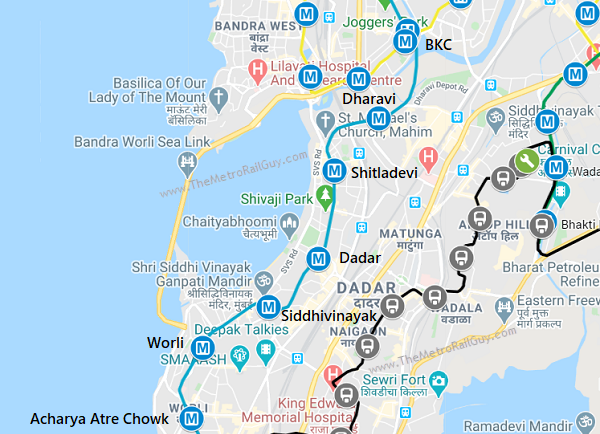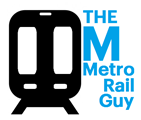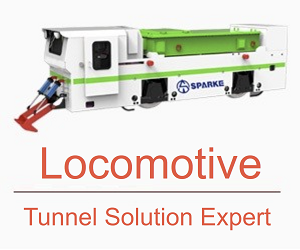Mumbai Metro Line 3’s Trial Runs Extended to Dadar Station
Mumbai Metro Rail Corporation (MMRC) this Tuesday extended trial runs (train testing) on Mumbai Metro’s 33.5 km Line-3 (Aqua Line) from Bandra Kurla Complex (BKC) up to Dadar Station.
MMRC and Alstom Transport’s teams manually operated one of their 8 coach Alstom Metropolis trains at a low-speed of 10 kmph on the up-line tracks up to Dadar Station through Dharavi and Shitladevi stations, a distance of roughly 4.3 km from BKC Station.
This is the first time a metro train has entered South Mumbai (also known as South Bombay or Island City). I shared a video with a front-on view from the train’s cabin on my Patreon page earlier in the week.
As always, the sole objective of the first run was to check for Schedule of Dimensions (SOD) clearances and observe the train’s interaction with the civil structure to ensure there are no physical obstructions along the way.

The section’s twin tunnels were built by J Kumar Infraprojects – China Railway Tunnel Group JV (4.94 km Package UGC-05: CSIA to Dharavi) and by Continental Engineering Corp – ITD Cementation – Tata Projects JV (6.08 km Package UGC-04: Dharavi to Worli).
Final tunnel breakthroughs for both packages were recorded all the way back in 2020 by TBM S-1073 (Krishna-1) on UGC-04 and TBM S64 (Godavari-4) on UGC-05.
To facilitate this low-speed run, Alstom Transport which is coincidentally the traction contractor (Package 11A) on May 3 energized the line’s 25 kV overhead electrification (OHE) system within the up-line tunnel. Here’s a notification published in the newspapers by MMRC:

Some snaps from the trial run shared by a follower:



After the final tunnel breakthrough, operators elsewhere in India have taken no more than 2 years to finish system installation, station architectural finishing & testing to operationalize their metro lines, so clearly Line-3 is running terribly behind schedule.
While the drama surrounding Aarey Depot & its Operational Control Centre‘s construction was legit and affected the start of integrated trial runs, it never was the long pole on the critical path of commissioning. System installation and station architectural finishing (see pics) works were.
Anyhow, Line-3’s opening has been divided into 3 phases. Train testing on Phase 1 (Aarey Colony – BKC) with 10 stations started in August 2022. Proper integrated testing finally started in March 2024 with all systems (eg. signaling, telecommunications, track) currently certified by Bureau Veritas – MMRC’s Independent Safety Assessor (ISA).
Phase 2 (BKC – Acharya Atre Chowk) with 6 underground stations will be the next to open, which I envision will happen no more than 6 months from the opening of Phase 1. Back in December 2022, I was looking at a Q3 2024 (July – September) opening looking at all the post-tunneling activities pending and still stand by that timeframe.
For more updates, check out the Mumbai section or my Home Page! Sign up for free instant email notifications on new posts over here. Like this post? Get early-access to updates and support the site over here.
– TMRG




Mumbai Metro Line 12 initial works like Soil testing & Pilling also started🥳.
Cool, trying to source some ground pics
Hi sir I want to join line 3 so can you help me for that and whom I can give the interview for line 3 can you tell me please
i wanna see the crowd after this lines open.
Waiting for the same..
Metro Line 3 (Colaba-Bandra-SEEPZ) could become comparable to Delhi Metro’s Yellow Line in terms of ridership and significance.
But better & more modern
Yes, Mumbai Metro Line 3 is poised to be more modern and technologically advanced than Delhi Metro’s Yellow Line, reflecting advancements in urban transport infrastructure and design.
I’m honestly a bit lost as to why there continue to be such delays on this line. If depot works are nearly complete, station architecture/systems works have been ongoing for over 3 years now, why are they still in “pre-trial”/”partial trial” stages?
The delays in Mumbai Metro Line 3 are a result of a multitude of challenges spanning legal, technical, environmental, and logistical domains. While these have significantly pushed back the project timeline, ongoing efforts are aimed at overcoming these hurdles to bring this modern metro line into full operation as soon as possible.